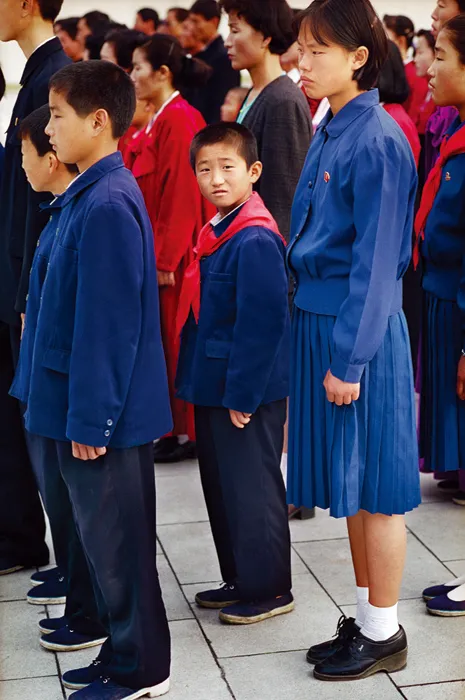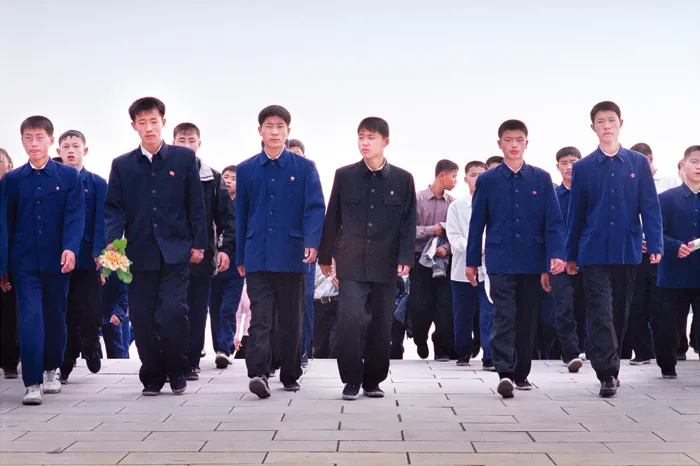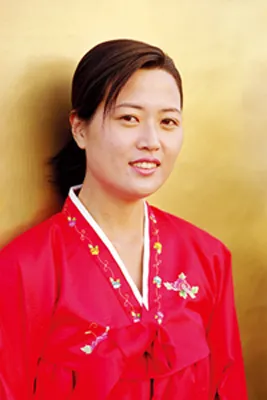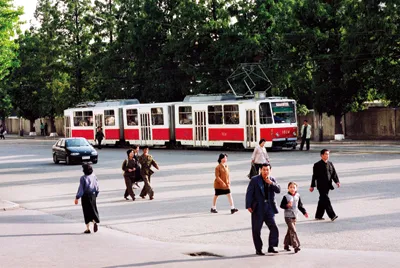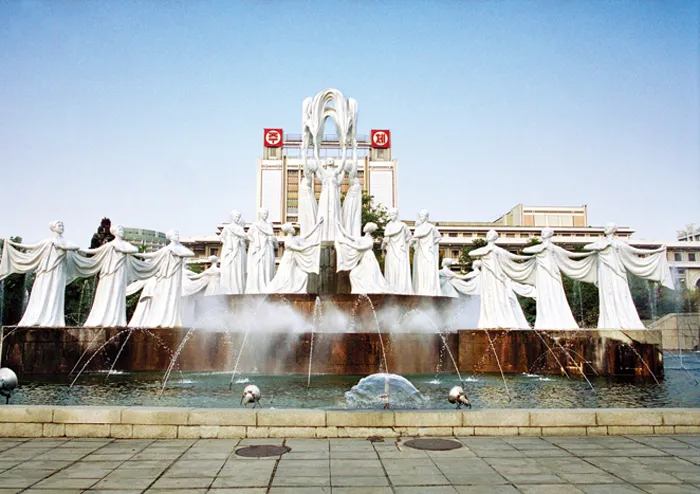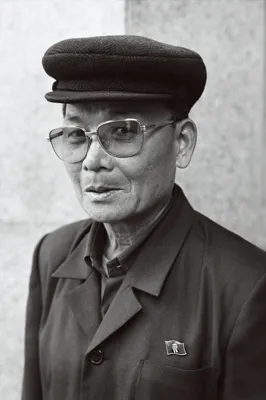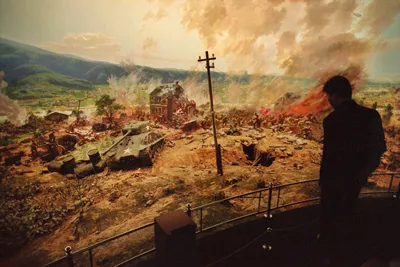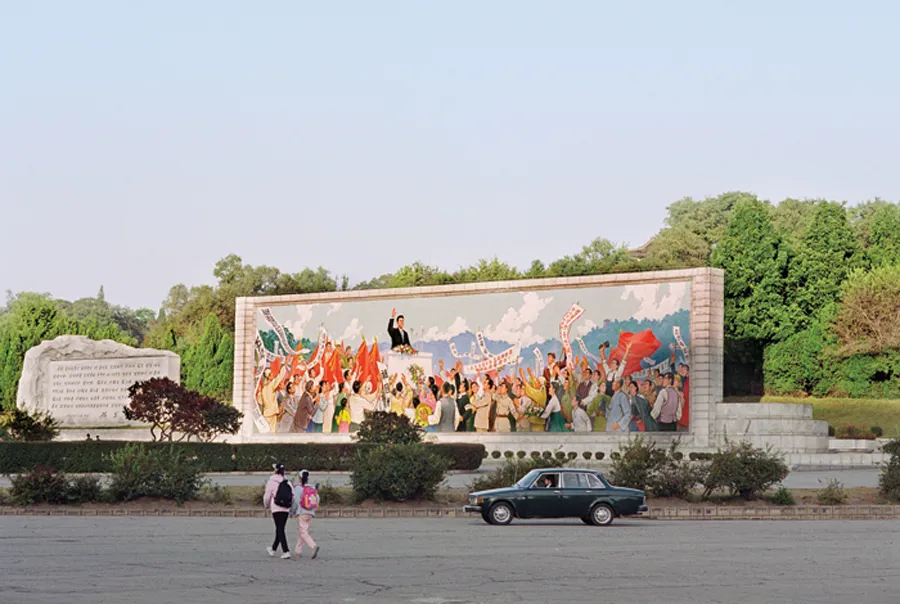![]()
INSIDE THE HERMIT KINGDOM
Performers at the 2005 Arirang Mass Games in Pyongyang.
![]()
PYONGYANG
PYONGYANG IS THE CAPITAL CITY OF North Korea. The official population of the city is not disclosed; it was reported as 3.8 million in 2003 by Chosen Soren, a pro-North Korean organization based in Japan. During the Three Kingdoms period (BCE 57-676 CE), the Goguryeo kingdom moved its capital to what is now Pyongyang in 427. The modern English name “Korea” derives from the medieval Korean kingdom of Goryeo, which in turn took its name from “Goguryeo.”
In the ensuing years, kingdoms came and went with geopolitical upheavals and foreign invasions, including the Japanese invasion of 1592. In 1910, the Korean peninsula was annexed by Japan and was controlled by the country until the end of World War II in 1945. With the end of Japanese rule, Korea was divided in half at the thirty-eighth parallel, with the North occupied by Soviet forces, the South by the United States. Pyongyang became the capital of the Democratic People’s Republic of Korea at its establishment in 1948. Though still acting in support of their respective halves of the country, both the United States and the Soviets had withdrawn most of their forces by 1949. Tensions for unification of the country from both north and south—each on their own terms—came to a head when some seventy thousand North Korean troops crossed the thirty-eighth parallel in June 1950, marking the beginning of the Korean War. By the time of the armistice three years later, Pyongyang lay mostly in ruins. The city was rebuilt with Soviet help, many buildings with a Stalinist architectural flavor. Massive Soviet-style monuments and large apartment blocks are located around the capital, as are images of Kim II Sung (The Great Leader) and Kim Jong II (The Dear Leader).
While the city’s monuments are its most immediately striking feature, the capital is also notable for its wide, mostly empty streets and boulevards. Personal ownership of vehicles is no longer specifically limited, but few cars are visible (fuel shortages are a constant in the DPRK), the streets sparsely occupied by bicycles, pedestrians, and a few city buses. Advertising is also notably absent, though patriotic slogans are common on buildings, monuments, and billboards throughout the city. The relative emptiness is accentuated by regular relocations of as many as a million of Pyongyang’s residents to the countryside to help with annual harvests. At night, the city is mostly dark, the result of electricity shortages and scheduled blackouts, ostensibly for security reasons (though power in international hotels and the lighting on key monuments is maintained). Sounds can carry for miles; the night sky is unusually clear and the stars surprisingly bright above a national capital city. The whole country appears in satellite images as a dark form between the lights of China and South Korea. Patriotic music plays from loudspeakers in the city each morning, and occasional air-raid drills sound across the city for residents to take cover in response to their government’s expressed expectation of a U.S. nuclear attack.
At Pyongyang’s Sunan Airport, disembarking passengers are welcomed by the smiling portrait of the Great Leader, Kim Il Sung. Four to five flights, on average, depart each week from the airport.
North Koreans bow to a 65-foot bronze statue of Kim Il Sung, erected in 1972 to celebrate his sixtieth birthday, at the top of Mansu Hill. Foreigners are warned that any sign of disrespect will not be tolerated. Offenses include imitating the position of the statue or photographing just the feet.
Schoolchildren at the Mansudae Grand Monument pay tribute to Kim Il Sung.
Students at the Mansudae Grand Monument.
The Monument to the Workers’ Party of Korea was erected on the fiftieth anniversary of its founding. Laborers are represented by the hammer, intellectuals by the calligrapher’s brush, and farmers by the sickle.
A park with Mansu Hill and the uncompleted, pyramid-shaped International Ryugyong Hotel in the background. Construction of the hotel began in 1987 but was halted four years later, with no official statement as to why, amid rumors that the 105-story building is structurally unsound. It remains unfinished and unoccupied.
A tour guide at the base of Juche Tower wearing a pin depicting Kim Il Sung.
Situated at the edge of the Taedong River, the 557-foot Juche Tower celebrates the philosophy of nationalistic self-reliance put forward by Kim Il Sung (also known as Kimilsungism) that is the guiding philosophy of the DPRK. The tower, based on an architectural style derived from the stone pagodas of premodern Korea, was completed on April 15, 1982, in honor of Kim’s seventieth birthday.
A view of office and apartment buildings from the top of Juche Tower. The sign in the foreground translates as “One heart.”
A trolley on the streets of Pyongyang.
The characters on the side of the trolley read “We serve the people!”
Fountains across the street from the Grand People’s Study House, which was built in 1982 to celebrate Kim Il Sung’s seventieth birthday, and serves as the city’s main library.
A father and son in a park near the Taedong River.
The Mansudae Grand Monument on Mansu Hill celebrates the efforts of workers under a banner of the Korean Workers’ Party.
An image of a Korean War battle at the Victorious Fatherland Liberation War Museum. The museum hosts a cyclorama depicting the Battle on Height 1211, fought during the Fatherland Liberation War (the Korean War).
A roadside mural depicts the hero’s welcome that met the arrival of Kim Il Sung near Pyongyang Municipal Stadium (la...




